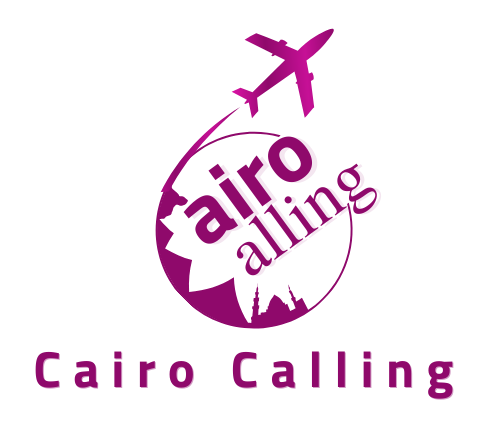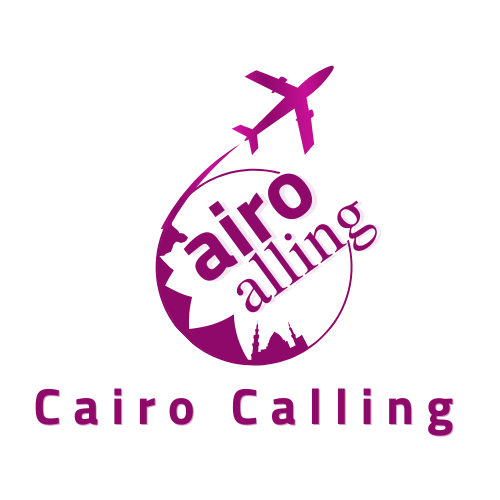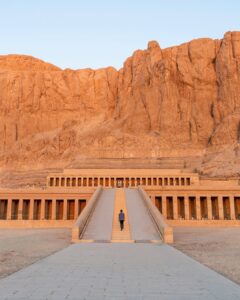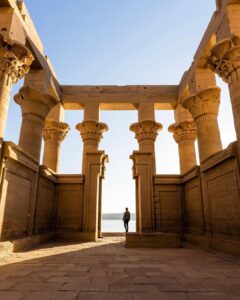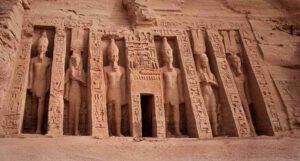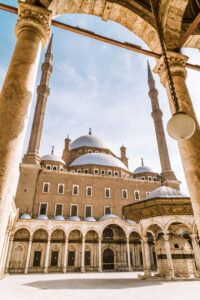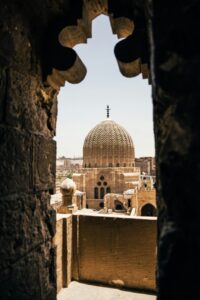Historical Background Greco-Roman Period
Constructed during the Greco-Roman period, the Temple of Kom Ombo was built around the 2nd century BCE, during the reign of King Ptolemy VI Philometor. It represents a unique blend of Egyptian and Hellenistic architectural styles, reflecting the cultural influences of the time.
Construction Details
Crafted from sandstone blocks quarried from nearby cliffs, the temple’s construction was a monumental undertaking. Its strategic location along the Nile made it a vital religious center and pilgrimage site for worshippers across Egypt.
Dual Dedication Sobek, the Crocodile God
One of the distinctive features of the Temple of Kom Ombo is its dual dedication to Sobek, the crocodile god, and Horus, the falcon god. Sobek, revered as the deity of fertility and protection, was closely associated with the Nile and its life-giving waters.
Horus, the Falcon God
Horus, the falcon-headed god of kingship and the sky, was also worshipped at the temple. As the son of Osiris and Isis, Horus symbolized divine kingship and the triumph of good over evil, making him a central figure in Egyptian mythology.
Architectural Features
The Temple of Kom Ombo boasts impressive architectural features that reflect the ingenuity and skill of ancient Egyptian builders.
Symmetrical Design
One of the most striking aspects of the temple is its symmetrical design, with twin entrances, halls, and sanctuaries dedicated to Sobek and Horus. This symmetry reflects the balance and harmony inherent in Egyptian cosmology.
Hypostyle Halls
The temple’s hypostyle halls are adorned with towering columns intricately carved with hieroglyphics and scenes from ancient myths and rituals. These grand halls served as gathering places for worshippers and priests, where religious ceremonies and offerings were conducted.
Nilometers
Adjacent to the temple are ancient Nilometers, structures used to measure the water levels of the Nile River. These devices were essential for monitoring flood patterns and assessing agricultural conditions, highlighting the temple’s practical as well as spiritual significance.
Religious Significance Healing Sanctuary
The Temple of Kom Ombo was renowned for its healing powers, attracting pilgrims seeking relief from various ailments and diseases. Dedicated chambers within the temple contained inscriptions and reliefs depicting medical instruments and healing rituals, underscoring its role as a sanctuary of health and wellness.
Medical Instruments and Reliefs
Carved reliefs found within the temple depict a variety of medical instruments and procedures, offering valuable insights into ancient Egyptian healthcare practices. These depictions include scenes of surgery, childbirth, and medical treatments administered by temple priests.
Visitor Experience Tourist Attractions
Today, the Temple of Kom Ombo remains a popular tourist destination, drawing visitors from around the world eager to explore its ancient wonders. Tourists can marvel at the temple’s intricate carvings, explore its sacred chambers, and learn about its religious significance through guided tours and interactive exhibits.
Guided Tours
Knowledgeable guides lead visitors through the temple’s labyrinthine corridors, sharing stories of ancient rituals, myths, and legends associated with Sobek and Horus. Visitors can immerse themselves in the rich tapestry of Egyptian history and culture, gaining a deeper appreciation for the mysteries of the ancient world.
Cultural Significance
The Temple of Kom Ombo holds immense cultural significance as a symbol of Egypt’s enduring legacy and spiritual heritage. Its preservation serves as a testament to the country’s commitment to safeguarding its ancient treasures for future generations to cherish and explore.
Preservation Efforts
In recent years, extensive restoration projects have been undertaken to preserve and protect the Temple of Kom Ombo from the effects of time and environmental factors. These efforts, supported by UNESCO and other organizations, aim to ensure that this architectural marvel continues to inspire awe and wonder for centuries to come.
Conclusion
The Temple of Kom Ombo stands as a timeless testament to the ingenuity, spirituality, and artistic mastery of ancient Egypt. Its dual dedication to Sobek and Horus, coupled with its architectural splendor and religious significance, continues to captivate visitors and scholars alike, offering a window into the mysteries of Egypt’s distant past.
Frequently Asked Questions
- Is the Temple of Kom Ombo open to the public?
- Yes, the temple welcomes visitors throughout the year.
- Are guided tours available at the temple?
- Yes, guided tours led by knowledgeable experts are available for visitors interested in learning more about the temple’s history and significance.
- What is the significance of the dual dedication to Sobek and Horus?
- The dual dedication reflects the harmonious balance of opposing forces in Egyptian mythology and cosmology.
- What medical treatments were offered at the Temple of Kom Ombo?
- The temple was renowned for its healing powers and offered a variety of medical treatments and rituals to pilgrims seeking relief from ailments.
- How long does it take to explore the entire temple complex?
- Most visitors spend about 1-2 hours exploring the temple and its surroundings.
